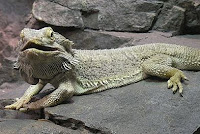 The bearded dragon has
a very fitting name. This favorite among collectors lives up to its name by
sporting a beard. The beard is actually a hunk of skin that hangs under its
mouth. The skin has spines, and when the animal feels threatened, it can cause the
beard to puff up to make it appear larger and scarier.
The bearded dragon has
a very fitting name. This favorite among collectors lives up to its name by
sporting a beard. The beard is actually a hunk of skin that hangs under its
mouth. The skin has spines, and when the animal feels threatened, it can cause the
beard to puff up to make it appear larger and scarier.
If you go to
Australia, you may just see one of them in the desert or in the wooded areas.
They enjoy the brush, and they like to lay on branches and rocks to take in
some sun. It is common to see them near populated areas, as well. This affords
them the opportunity for more shelter and bits of discarded food.
Though they are
harmless, bearded dragons look quite dangerous to their enemies. The sides of
their heads are lined with spiked scales, and those spikes run down the sides
or their bodies. Though they are not actually sharp, a predator may think they
are, and they also serve as protection for the lizard’s skin. The lizard is
flat, and therefore it lies close to the ground, but its belly is rounded on
the sides making it look plumper than it really is.
If you were watching a
bearded dragon as it met up with its fellow beardies, you might think it to be
quite friendly. It will often wave its hand to let the others know that it
wants to be friendly and not aggressive. While it would be interesting to see,
they do not shake hands, just wave them.
They may also change
colors when they are cold. The darker color retains more heat. If that doesn’t
do the trick, they will dig down and camp under rocks and dirt to get out of
the cold. They sometimes even hibernate, which in their case is more properly
called brumation – a form a dormancy. When the dragon does this, it slows its
metabolism down so that it expends less energy, and it can live with minimal amount
of food.
Pogona is the official
name of the genus, and the agamid lizard, or dragon lizard, is of that genus.
The Pogona vitticeps is the official name of the bearded dragon, and it is the
one most often kept by pet owners. Collectors also call them beardies.
Those kept by
collectors can grow to almost two-feet long and weigh over a pound; however, in
the wild, they will grow to be a foot to a foot and a half long. That is
because of the availability of food and the life span difference. Food can be
scarce for them in the wild, but in captivity they are fed a variety of
insects, fruits and vegetables.
If you are considering an exotic pet that you and your children will enjoy, a beardie would be a good choice. They are good with children, and they are mild mannered and easy to care for. Many owners find themselves just spending hours
watching and musing over their bearded dragon.